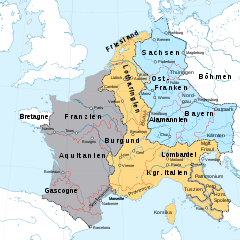Treaty of Verdun
The Treaty of Verdun, signed in August 843, was the first of the treaties that divided the Carolingian Empire into three kingdoms among the three surviving sons of Louis the Pious, who was the son of Charlemagne. The treaty, signed in Verdun-sur-Meuse, ended the three-year Carolingian Civil War.
 Division of the Frankish Empire at the Treaty of Verdun in 843.
| |
| Date | August 843 |
|---|---|
| Location | Verdun-sur-Meuse |
| Participants | Lothair I, Louis the German, Charles the Bald |
| Outcome | Divided territories of the Carolingian Empire into three kingdoms; Influenced inheritances and conflicts in Western Europe as late as the 20th century. |
Background
Following Charlemagne's death, Louis was made ruler of the Carolingian empire. During his reign, he divided the empire so that each of his sons could rule over their own kingdom under the greater rule of their father. Lothair I was given the title of emperor but because of several re-divisions by his father and the resulting revolts, he became much less powerful. When Louis the Pious died in 840, his eldest son, Lothair I, claimed overlordship over the entirety of his father's kingdom in an attempt to reclaim the power he had at the beginning of his reign as emperor.[1] He also supported his nephew, Pepin II's claim to Aquitaine, a large province in the west of the Frankish realm. Lothair's brother, Louis the German, and his half-brother Charles the Bald refused to acknowledge Lothair's suzerainty and declared war against him.[1] After a bloody civil war, they defeated Lothair at the Battle of Fontenay in 841 and sealed their alliance in 842 with the Oaths of Strasbourg which declared Lothair unfit for the imperial throne, after which he became willing to negotiate a settlement.
Provisions
Each of the three brothers was already established in one kingdom: Lothair in the Kingdom of Italy; Louis the German in Kingdom of Bavaria; and Charles the Bald in the Kingdom of Aquitaine.
- Lothair I received Middle Francia, the central portion of the empire.
- In the settlement, Lothair (who had been named co-emperor in 817) retained his title as emperor, but it conferred only nominal overlordship of his brothers' lands.[2]
- His domain later became the Low Countries, Lorraine, Alsace, Burgundy, Provence, and the Kingdom of Italy (which covered the northern half of the Italian Peninsula). He also received the two imperial cities, Aachen and Rome.
- Louis the German received the East Francia portion of the empire.
- He was guaranteed the kingship of all lands to the east of the Rhine (although not the Netherlands to the north of the Rhine) and to the north and east of Italy, plus the Rhineland west of the Rhine, altogether called East Francia. It eventually became the High Medieval Kingdom of Germany, the largest component of the Holy Roman Empire.
- Charles the Bald received the West Francia portion of the empire, which later became the Kingdom of France.
- Pepin II was granted the Kingdom of Aquitaine, but only under the authority of Charles. Charles received all lands west of the Rhône, called West Francia.
After Lothair's death in 855, Upper Burgundy and Lower Burgundy (Arles and Provence) passed to his third son, Charles of Provence, and the remaining territory north of the Alps to his second son, Lothair II, after whom the hitherto nameless territory was called Lotharingia. It would then become modern Lorraine. Lothair's eldest son, Louis II, inherited Italy and his father's claim to the Imperial throne.
Legacy
The division reflected an adherence to the old Frankish custom of partible or divisible inheritance amongst a ruler's sons, rather than primogeniture (i.e., inheritance by the eldest son) which would soon be adopted by both Frankish kingdoms.
Since the Middle Frankish Kingdom combined lengthy and vulnerable land borders with poor internal communications as it was severed by the Alps, it was not a viable entity and soon fragmented. This made it difficult for a single ruler to reassemble Charlemagne's empire. Only Charles the Fat achieved this briefly.
In 855, the northern section became fragile Lotharingia, which became disputed by the more powerful states that evolved out of West Francia (i.e., France) and East Francia (i.e., Germany). Generations of kings of France and Germany were unable to establish a firm rule over Lothair's kingdom.[3] While the north of Lotharingia was then composed of independent countries, the southern third of Lotharingia, Alsace-Lorraine, was traded back and forth between France and Germany from the 18th to the 20th century. In 1766, it passed to France after the death of Stanisław Leszczyński, who had acquired the region from the German Habsburgs by the Treaty of Vienna (1738) ending the War of Polish Succession (1733-1738). In 1871, Alsace-Lorraine became German, after the victory of Prussia and its German allies over the French in the Franco-Prussian War (1870-1871). In 1919, it became French again by the Treaty of Versailles (1919), following the French victory over the Germans in World War I (1914-1918). In 1940, Germany reannexed Alsace-Lorraine following Germany's successful invasion of France. Finally, in 1945, after World War II (1939-1945), Alsace-Lorraine was solidified as French territory, which it remains to this day, more than a thousand years after the Treaty of Verdun. The collapse of the Middle Frankish Kingdom also compounded the disunity of the Italian Peninsula, which persisted into the 19th century.
See also
- Oaths of Strasbourg
- Treaty of Prüm (855)
- Treaty of Meerssen (870)
- Treaty of Ribemont (880)
Notes
- "What was the Treaty of Verdun?". ThoughtCo. Retrieved 15 May 2017.
- Friedrich Heer, The Holy Roman Empire, pg. 20
- "Treaty of Verdun: 843". www.thenagain.info. Retrieved 15 May 2017.
External links
